Related Research Articles
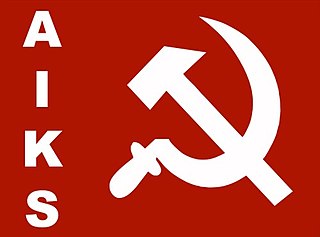
The All India Kisan Sabha (AIKS), or All India Kisan Sabha , is the peasants front of Communist Party of India (Marxist), and works for farmers rights, peasants rights and anti-feudal movement in India.

All India Kisan Sabha, is the peasant or farmers' wing of the Communist Party of India, an important peasant movement formed by Sahajanand Saraswati in 1936.

The history of Bihar is one of the most varied in India. Bihar consists of three distinct regions, each has its own distinct history and culture. They are Magadha, Mithila and Bhojpur. Chirand, on the northern bank of the Ganga River, in Saran district, has an archaeological record dating from the Neolithic age. Regions of Bihar—such as Magadha, Mithila and Anga—are mentioned in religious texts and epics of ancient India. Mithila is believed to be the centre of Indian power in the Later Vedic period. Mithila first gained prominence after the establishment of the ancient Videha Kingdom. The kings of the Videha were called Janakas. A daughter of one of the Janaks of Mithila, Sita, is mentioned as consort of Lord Rama in the Hindu epic Ramayana. The kingdom later became incorporated into the Vajjika League which had its capital in the city of Vaishali, which is also in Mithila.
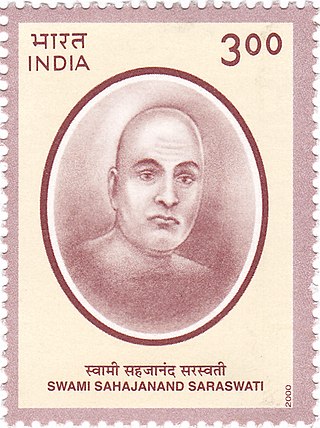
Sahajanand Saraswati was an ascetic, a nationalist and a peasant leader of India. Although born in United Provinces, his social and political activities focussed mostly on Bihar in the initial days, and gradually spread to the rest of India with the formation of the All India Kisan Sabha. He had set up an ashram at Bihta, near Patna, Bihar carried out most of his work in the later part of his life from there. He was an intellectual, prolific writer, social reformer and revolutionary.
Namasudra, earlier known as Chandal, is an Avarna Bengali Hindu community originating from eastern and central Bengal. The term Chandal or Chandala is usually considered as a slur. They were traditionally engaged in fishing and as boatmen, and later in cultivation. They lived outside the four-tier ritual varna system and thus were outcastes.

Sir Ponnambala Thiaga Rajan was the Chief Minister of Madras Presidency from 4 April 1936, to 24 August 1936. He was also the last President of the Justice Party. P. T. Rajan was born in a Thondaimandala mudaliar family in Uthamapalayam. His ancestors were from Kanchipuram. He attended The Leys School, Cambridge and later, Jesus College, Oxford. He graduated in history and law, and practiced as an advocate for some time before joining the Justice Party.
Neyamatpur is a village in Gaya district of Bihar, India. The village was a bastion of the Indian National Congress and Kisan Andolan during the British period. "Pandit" Yadunandan Sharma, at the instruction of Swami Sahajanand Saraswati established an ashram here in 1933.
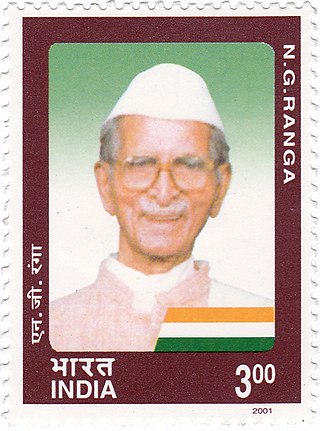
Acharya Gogineni Ranga Nayukulu, also known as N. G. Ranga, was an Indian freedom fighter, classical liberal, parliamentarian and farmers' leader. He was the founding president of the Swatantra Party, and an exponent of the peasant philosophy. He received the Padma Vibhushan award for his contributions to the Peasant Movement. N.G. Ranga served in the Indian Parliament for six decades, from 1930 to 1991.
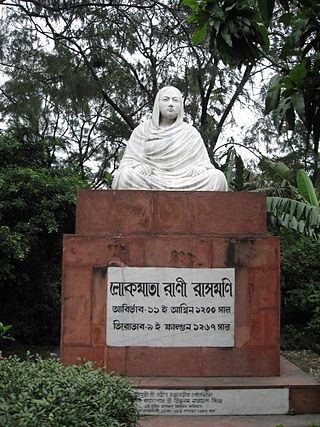
Mahishya, also spelled Mahisya, is a Bengali Hindu traditionally agrarian caste, and formed the largest caste in undivided Bengal. Mahisyas were, and are, extremely diverse Bengali caste counting among themselves all possible classes in terms of material conditions and ranks.
Tipu Shah was the second leader of the mystic Pagal Panthi Order in Mymensingh. He commanded the Order and the local peasantry in revolts against the British East India Company and managed to establish an independent state in Sherpur.
Bhumihars, also locally called Bhuinhar and Babhan, are a Hindu caste mainly found in Bihar, the Purvanchal region of Uttar Pradesh, Jharkhand, the Bundelkhand region of Madhya Pradesh, and Nepal.
The Bharatiya Kisan Sangh (BKS) is an Indian farmers' organization that is politically linked to the Rashtriya Swayamsevak Sangh, and a member of the Sangh Parivar. BKS was founded by Dattopant Thengadi in 1978. As of 2000, Rashtriya Swayamsevak Sangh claimed BKS had a quarter million members, organized in 11,000 villages and 301 districts across the country. The organization is dominated by landed gentry.
Manav Dharma Sabha was one of the earliest socio-religious reform organization in Gujarat and British India. It was founded on 22 June 1844 in Surat by Durgaram Manchharam Mehta, Dadoba Pandurang Tarkhadkar and a few others. The goals of the Sabha were to expose the hypocritical arts present in Christian, Muslim and Hindu religions. It had a very short life span and ceased to exist as Dadoba left for Bombay in 1846 and Durgaram left for Rajkot in 1852.
Paramahansa Mandali was a secret socio-religious group, established in 1849, in Bombay and is closely related to Manav Dharma Sabha which was found in 1844 in Surat. It was started by Durgaram Mehtaji, Dadoba Pandurang and a group of his friends. Dadoba Pandurang assumed leadership of this organisation after he left Manav Dharma Sabha. He outlined his principles in Dharma Vivechan in 1848 for Manav Dharma Sabha and "Paramhansik Bramhyadharma" for Paramahansa Mandali. It acted as a secret society and is believed that the revelation of its existence in 1860 hastened its demise.

The history of Uttar Pradesh, a state in India, stretches back several millennia. The region shows the presence of human habitation dating back to between 85,000 and 73,000 years ago. Additionally, the region seems to have been domesticated as early as 6,000 BC.
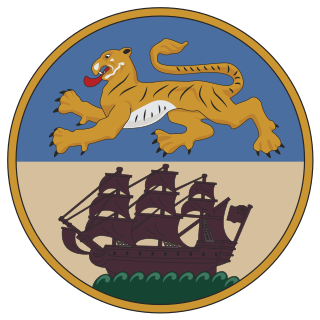
The Bengal Legislative Assembly was the largest legislature in British India, serving as the lower chamber of the legislature of Bengal. It was established under the Government of India Act 1935. The assembly played an important role in the final decade of undivided Bengal. The Leader of the House was the Prime Minister of Bengal. The assembly's lifespan covered the anti-feudal movement of the Krishak Praja Party, the period of World War II, the Lahore Resolution, the Quit India movement, suggestions for a United Bengal and the partition of Bengal and partition of British India.
Bharatiya Kisan Union (BKU) is a farmer's representative organisation in India. It was founded by Chaudhary Charan Singh from the Punjab Khetibari Union which became its Punjab branch. The union is affiliated to the All India Kisan Sangharsh Coordination Committee and Via Campesina. The national headquarters of the union is located in Sisauli, Uttar Pradesh.
The All India United Kisan Sabha was a peasants organization in India. The AIUKS was founded around the late 1940s by Swami Sahajanand Saraswati. Sahajanand had broken away from the All India Kisan Sabha in 1945, being opposed to the increasing communist domination of the movement. To form the new AIUKS, Sahajanand gathered Congress Socialist Party members and other Indian National Congress left-wing elements.
Sir Purshottamdas Thakurdas (1879–1961),, was a Gujarati cotton trader, mill owner, businessman and industrialist from Mumbai, India. He was one of the signatory of Bombay Plan, which was set of proposals for the post-independence economy of India. He along with GD Birla established the Federation of Indian Chambers of Commerce & Industry in 1927 on the advice of Mahatma Gandhi. He was a member of the Hilton Young Commission. He was a member of the Acworth Committee. He headed the Foodgrain Policy Committee of 1947.
Communist movements in India refers to the various social and political movements lead by communists in India. Communism in India has existed since the 1920s. Some of the major events are listed below.
References
- ↑ Pereira, Anthony W 1997. The End of the Peasantry. Pittsburgh: University of Pittsburgh Press.
- ↑ Social movements types at Sociology Guide
- ↑ Bandyopādhyāya, Śekhara (2004). From Plassey to Partition: A History of Modern India. Orient Longman. p. 406. ISBN 978-81-250-2596-2.
- ↑ Bandyopādhyāya, Śekhara (2004). From Plassey to Partition: A History of Modern India. Orient Longman. p. 406. ISBN 978-81-250-2596-2.
- ↑ Bandyopādhyāya, Śekhara (2004). From Plassey to Partition: A History of Modern India. Orient Longman. p. 407. ISBN 978-81-250-2596-2.
- ↑ States, Parties, and Social Movements, by Jack A. Goldstone. Cambridge University Press, 2003. ISBN 0-521-01699-1. Page 192.
- ↑ Habib, Irfan (2007). Essays in Indian History (Seventh reprint ed.). Tulika. p. 381 (at p 109). ISBN 81-85229-62-7.
- ↑ Chisholm 1911, p. 181.